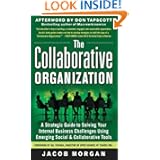Today’s interview is with Jacob Morgan, the Principal & Co-Founder of Chess Media Group, a management consulting and strategic advisory firm focused on collaboration. He has also authored of The Collaborative Organization, a best-selling book on collaboration strategy.
Increasing collaboration within organisations using social tools like Chatter, Yammer and Jive etc is increasingly becoming an area of focus amongst businesses as they seek to leverage internal social business tools to help improve communication, efficiency, knowledge sharing, employee engagement and other issues.
This interview follows on from my recent interview with Prof. John Seddon on Systems thinking, customer service and unlearning the way we do things and makes up number forty-three in the series of interviews with authors and business leaders that are doing great things and helping businesses innovate, become more social and deliver better service.
Highlights from the interview:
- Jacob published The Collaborative Organisation in the middle of 2012.
- He wrote the book on the back of a series of questions from clients that they were receiving about enterprise collaboration, how to do it, how to get support within an organisation, how to get started etc.
- Jacob also found that, at the time of writing, there wasn’t a comprehensive resource on collaboration strategy that people could go and refer to around enterprise collaboration.
- The book focuses on collaboration on the new social digital platforms that are emerging like Chatter, Yammer, Jive etc
- Jacob highlights the following as the biggest barriers to the use of collaborative tools in organisations: Lack of resources; Company culture doesn’t support collaboration; Managers themselves don’t get behind it and don’t use the tools themselves; Staff see the tools as just another ‘add-on’, just another initiative; There is no incentive for staff to use them; and Their use is not integrated into the employees’ regular workflow.
- The main reasons why main organisations start to think about employing collaborative tools and strategies include: Employees are spending too much time in their inboxes, Staff find it hard to locate subject matter experts and people; Companies find it hard to align staff with goals; Employees typically work in silos and it’s hard to get them out of their silos; Staff don’t share information that could be beneficial to others outside of their department or physical location; Executives want a better insight into what is happening within their companies; Issues with employee engagement; and Companies want to leverage collective intelligence to fuel innovation.
- Jacob shares a story about Lowe’s Home Improvement where one member of staff asked on their collaborative environment if any other stores had any spare stock of a particular product. This caught the attention of other stores who were having problems selling their stock of that item. They asked the original employee how she was able to sell so much of the product and she explained that she was conducting in-store demos of the productand that that was driving sales. Other stores started to adopt this technique and this materialised into an additional $1mill. in extra sales in a very short period of time.
- There is not set recipe to harness a higher level of collaboration.
- Sometimes, the environment and conditions may be right for collaboration but it can need kickstarting via something like appointing a group of local, regional or departmental leaders to lead the way and get collaboration started.
- Small as well as large companies can benefit from the increased use of collaborative tools.
- It’s all about sharing ideas and information, getting people out of their inboxes and releasing the intelligence that sits in people’s inboxes by making it available on an open and collaborative platform.
- Tops tips for getting started: 1. Understand the reason why increasing collaboration in your organisation is important; 2. Establish use-cases for employees on how they can use these tools and strategies and how they can benefit from them; and 3. Senior management support and use.
This was first posted on https://www.adrianswinscoe.com/.





